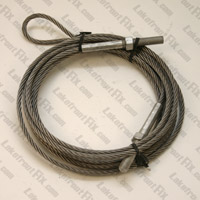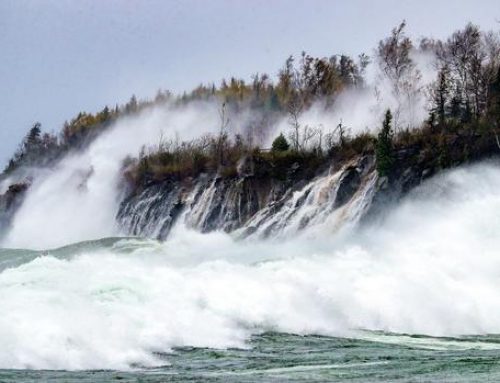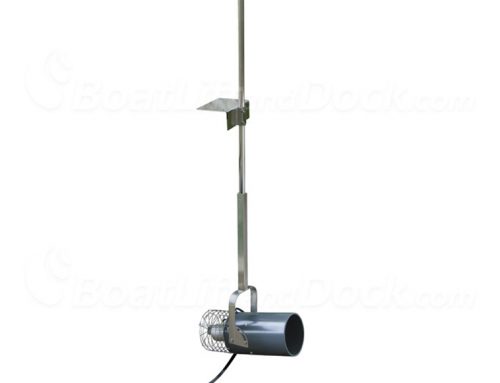The cables on your boat lift are perhaps the most important part of the whole unit, they tie the cradle assembly to the winch, allowing your watercraft to be raised and will be made of either stainless or galvanized steel. Both of these types of steel offer the benefit of corrosion resistance and strength, yet there are some differences that should be considered when you are making this decision.
When choosing a new boat lift cable or, if you are replacing the cables on an existing lift, you want to know that you are getting the right cable. Once you know the length and size of the cable you require, you want to then choose from the available options. If you have your owner’s manual, the part number, weight capacity, and type of cable should be listed, however, if it is not or you do not have an owner’s manual, you can contact a boat lift dealer and get assistance in determining what cables your lift requires.
Types of Steel
Galvanized Steel: Galvanized steel is carbon steel made corrosion resistant by the application of a thin layer of zinc oxides, usually through a “hot dip” in a zinc bath. This process is known as passivation, where a thin layer or coating is applied in order to increase a metal’s resistance to corrosion and other effects of nature.
Galvanized steel is less expensive than stainless steel due to the differences in the processing of each. Galvanized steel is very strong and each cable is made to accomplish the lift necessary for your unit. The downside to galvanized steel is that it is a less noble product, as we will discuss in a bit, and therefore has a higher electron-potential than stainless steel, making its corrosion resistance less effective.
Stainless Steel: Stainless steel is carbon steel which is mixed with about 10% chromium, which resists oxidation or corrosion. The chromium in the steel, when it is exposed to the atmosphere, forms a thin layer of chromium oxide that promotes resistance to corrosion.
The anti-corrosion nature of the chromium in the steel needs atmosphere or more specifically oxygen to maintain this property of resistance. If the cable or steel is in an oxygen starved environment the process or reaction cannot take place and the protective layer cannot regenerate over time; this can lead to damage known as crevice corrosion or pitting. This will increase if the steel is in salt water and can be prevented or reduced by rinsing the cables routinely in fresh water.
Some Science
Galvanic Scale: The galvanic position of a metal in the galvanic series determines its reactivity with other metals. Essentially this can be seen as a potential for the conductivity of voltage; the higher on the scale the more noble the metal; nobility indicating the level of corrosion resistance. Zinc, the main element in the process of manufacturing galvanized steel is lower on the galvanic scale than both chromium, the additive in stainless steel production, and manufactured stainless steel. As a general rule the more similar two metals are, that is, the closer they are on the scale, the less reactive they will be.
Galvanized steel, although corrosion resistant, is more prone to wear. The zinc layer can be scratched or crack through expansion and contraction, this can lead to spot rusting and a decreased life of the steel cable. Stainless steel, on the other hand, is blended with chromium oxide during manufacturing and therefore is resistant throughout, making its corrosion resistance regenerative.
Another issue to be considered in the choice of steel is the capacity to resist stray currents or electrolysis in the water. Steel is open to weakening through electrochemical processes that can occur naturally or through the power conditions on your dock or boat. Dissimilar or “antagonistic” metals such as aluminum and stainless steel can generate, when in contact, currents that can travel through the medium of water and affect other metals in their vicinity. Slight current leaks can also be introduced into the lift environment from the electrical conditions on board your craft or through the conditions/age of the shore power available on your dock or pier.
The coating, either zinc or chromium acts as a barrier between the steel and the elements, primarily water and oxidation elements, however, the presence of stray currents in the water around the boat lift and cables can, over time, weaken these properties of resistance, lessening the life of the cables.
In some regions the mineral content of the water can have adverse effects on the corrosion resistance of the steel in use. Chloride can cause or increase the rate of crevice corrosion or pitting in stainless steel. Chloride is what is known as an electronegative element, which means that it draws electrons toward itself and therefore is very reactive towards other elements and compounds in water.
Salt water, due to the increase in sodium chloride (salt) can induce pitting in stainless steel as chloride is more electronegative than both chromium (stainless steel) and zinc (galvanized steel). This willingness to share electrons lends chlorides a higher electron-potential and therefore can lead to a breakdown in the corrosion resistance of both zinc and chromium.
We see corrosion most commonly in the form of rust and this is why galvanized steel will rust over larger areas of its surface while stainless steel will spot rust or pit. The addition of chromium to the steel during the making of stainless steel creates a product that is regenerative and uniform in resistance throughout. Whereas galvanized steel, with its zinc coating, does not regenerate and when damaged exposes the steel beneath to the elements. Therefore the electrochemical reaction or damage we see as rust reflects the capacity for electron sharing to occur, lending stainless steel its greater resistance to corrosion.
It is our hope that this article will make such decisions easier and lend more confidence to you in your selection. Your boat lift is an investment and as such we want to make certain that we help you make a wise one.
© 2013 BoatLiftandDock.com









